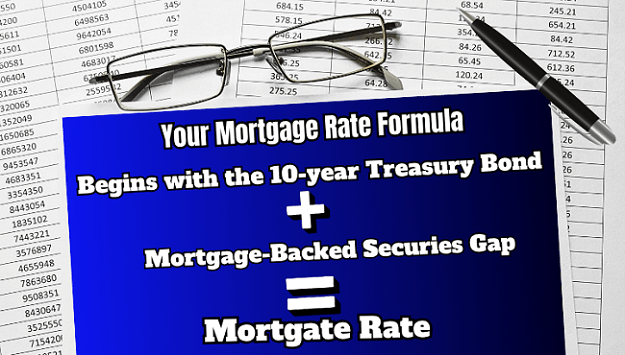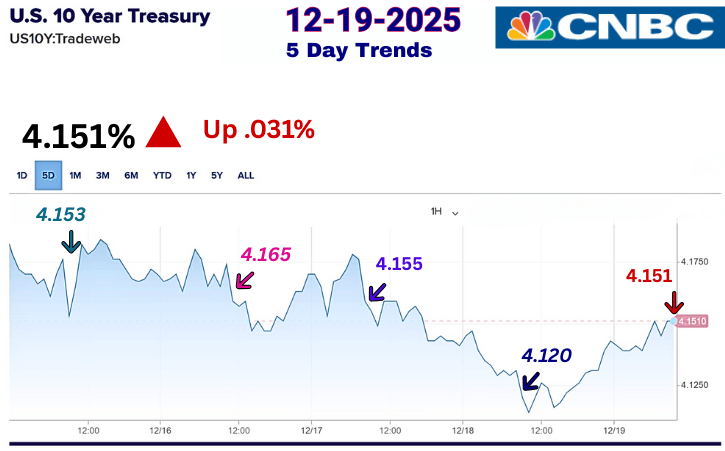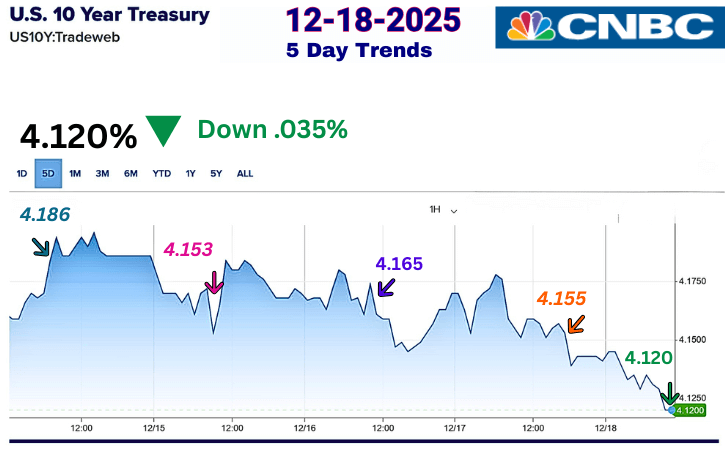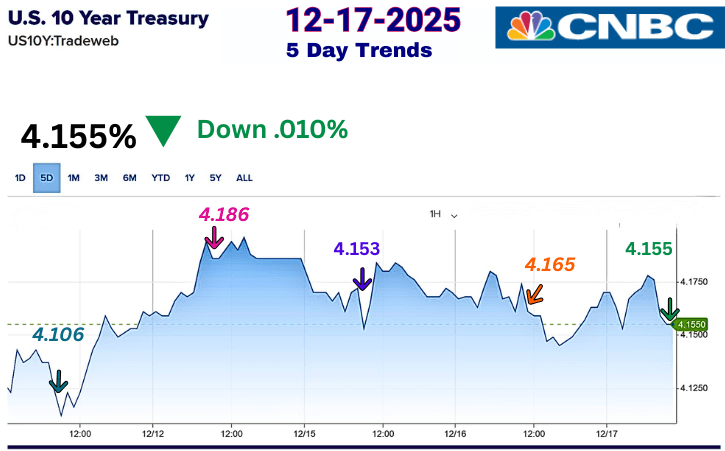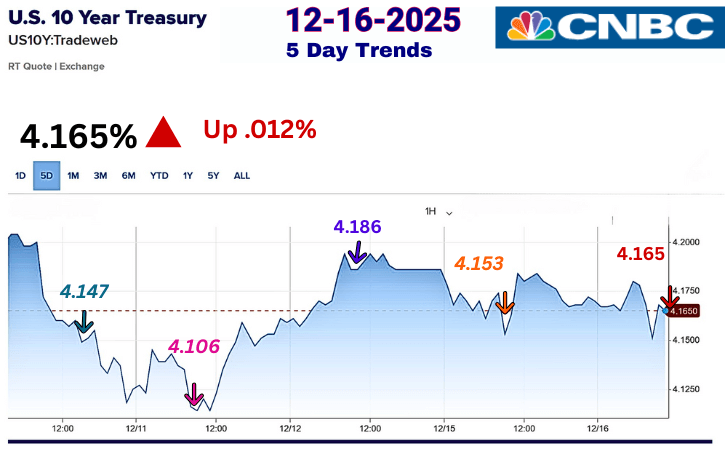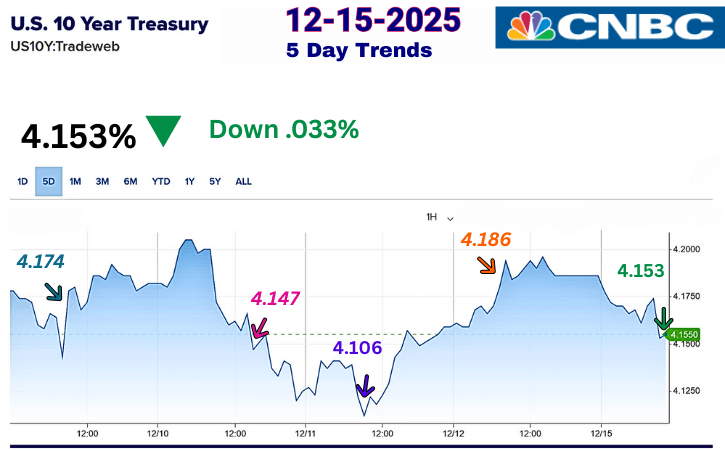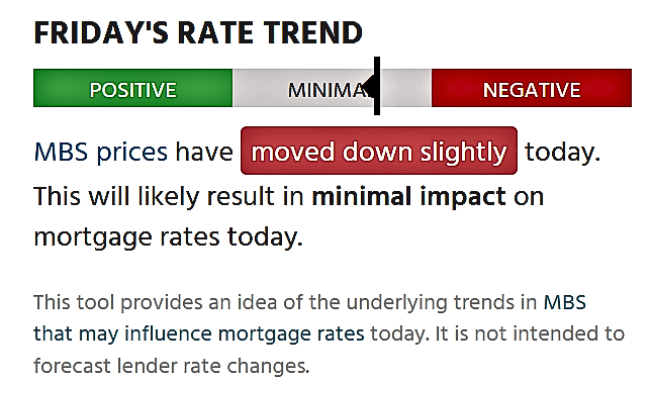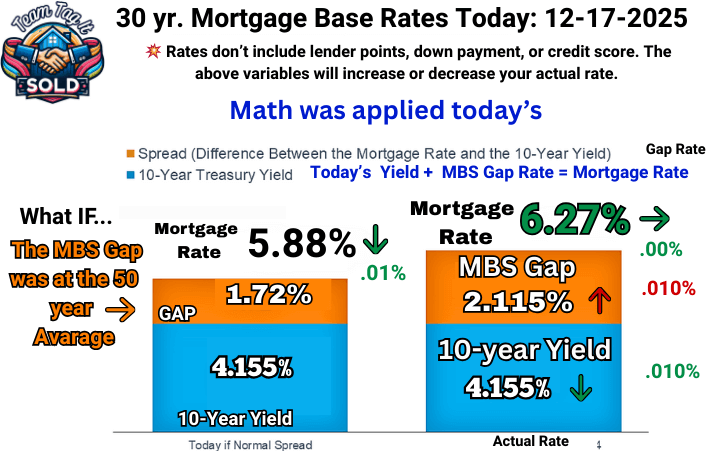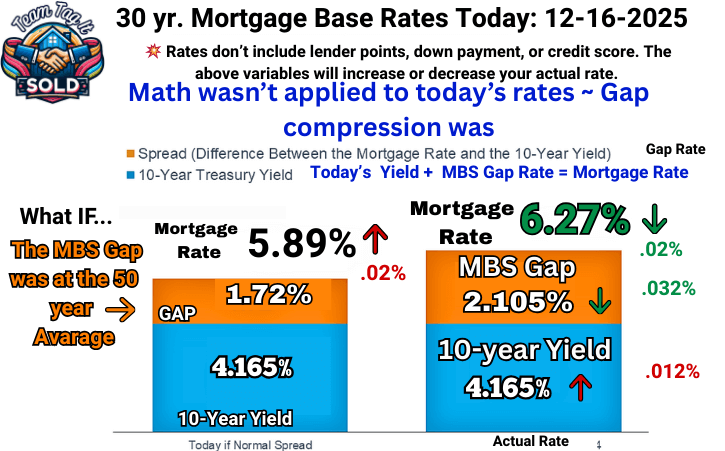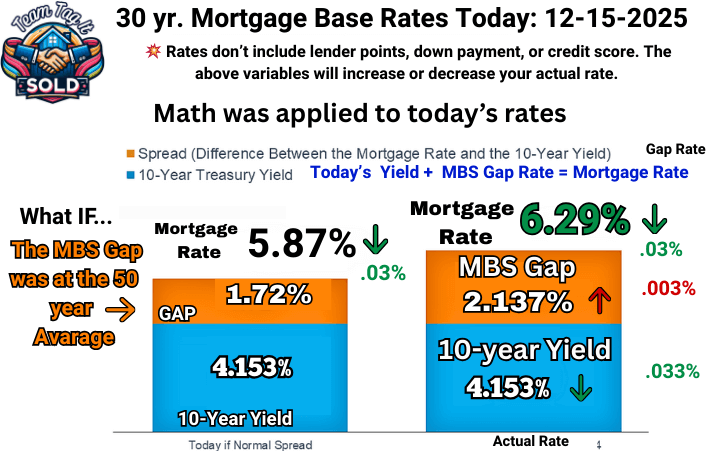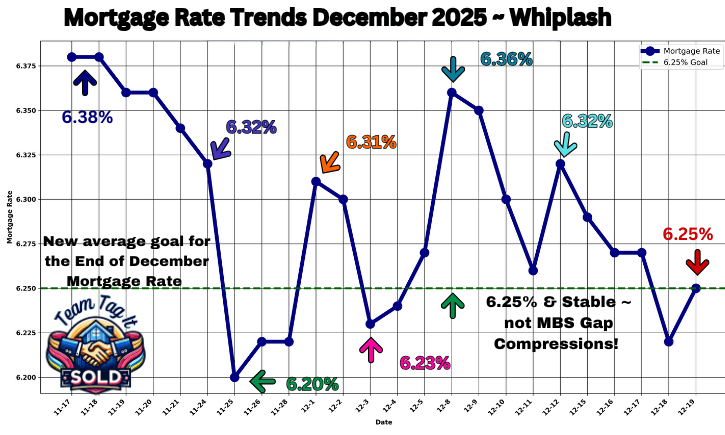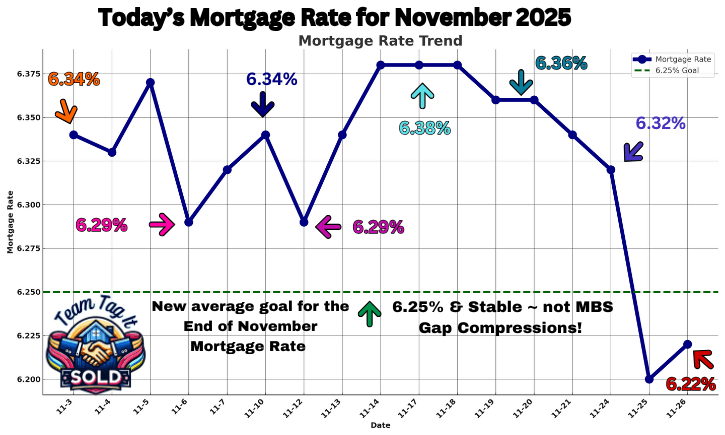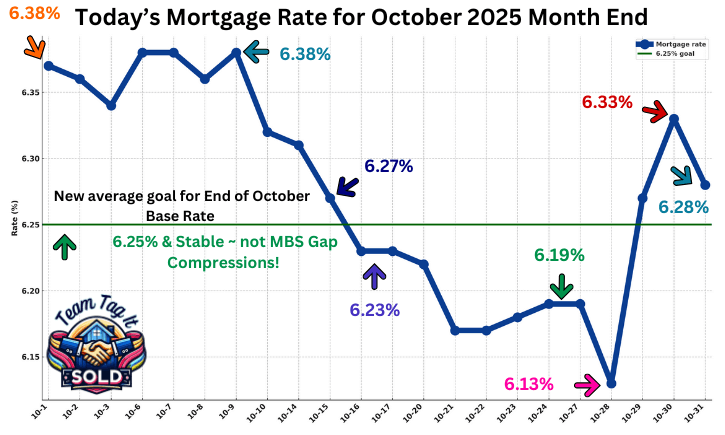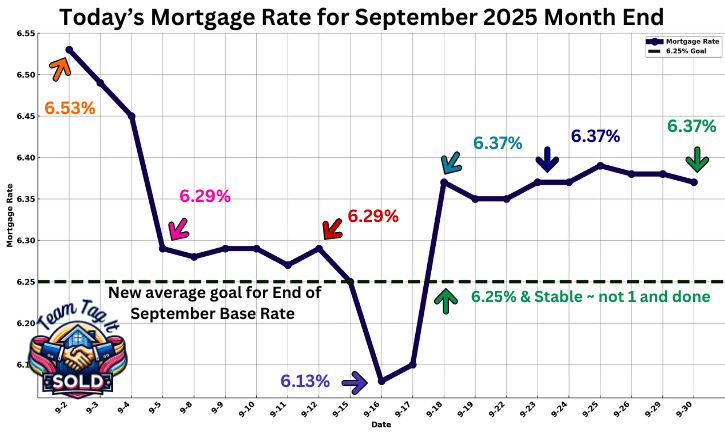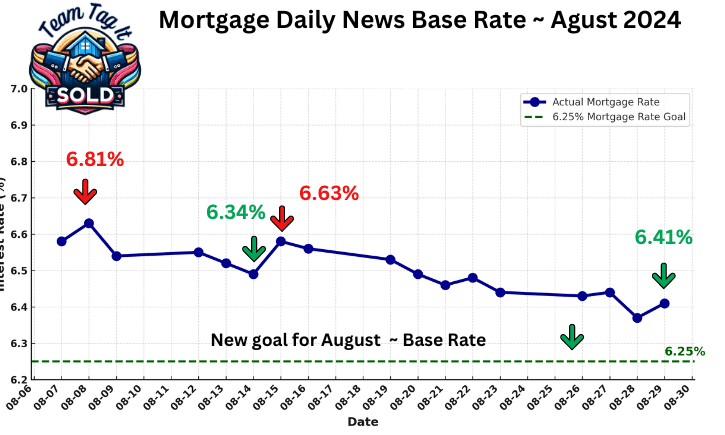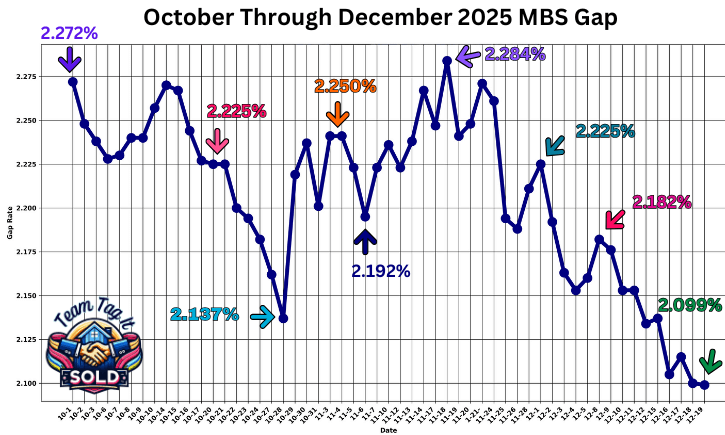Today’s Mortgage Rates: What’s Driving the Change 📈
I’m going to break down and explain the why in Today’s Mortgage Rates: What’s Driving the Change in Metro Detroit! Learn the why behind every rate move so you can spot trends before they shift. By understanding the bond market, the MBS gap, and the Fed’s hidden influence, you’ll know when to lock your rate on a dip—not a spike.
Updated: December 19 2025 • 10:30 AM ET ~ Round #1
Track the Why, not the what: 🗓️December 19, 2025
Today’s Mortgage Rates: What’s driving the change isn’t just about the daily number that pops up. It’s more about the WHY that caused the numbers to move. 💡Understanding the economic forces, Fed policy shifts, and bond market trends behind rate changes helps you make smarter, more confident decisions with your money. Each day, I break down the “WHY” behind the moves. It goes far beyond the headlines, revealing the deeper story of what drives rates and affects your monthly payment.💲
🚨 Morning Predictions: Wall Street isn’t a crystal ball, it’s a mood ring 📢
Yesterday’s CPI dip initially pushed the 10-year Treasury yield lower 📉. That move didn’t last. Once economists reviewed the report, confidence weakened — not because inflation disappeared, but because the CPI signal itself became questionable. Today’s slight rise in the yield reflects that reassessment.
What I found digging into the data
When I dug into the CPI data, a different story emerged. Spending didn’t collapse — it shifted. Consumers pulled back on discretionary purchases while continuing to pay for essentials. That matters because CPI is weighted. When volatile, discretionary categories cool, CPI can soften quickly — even if inflationary pressures haven’t fully resolved. This isn’t a data failure. It’s consumer stress showing up in the numbers.
🔻 Top 10 CPI Categories Driving the Decline
Shelter (Rent + Owners’ Equivalent Rent) 🏠
The most significant reported drop in over a year. This matters most because shelter is the most important CPI component.Lodging Away From Home (Hotels) 🏨
Apparent declines as travel demand cooled.Recreation 🎟️
Meaningful pullback in non-essential spending.Apparel (Clothing) 👕
Prices declined as retail demand softened.Food (Overall Inflation Slowed) 🍽️
Inflation cooled from 3.1% → 2.6% annually.
Not a price drop — a sharp slowdown.Food at Home (Groceries) 🛒
Grocery inflation eased significantly.Food Away From Home (Restaurants) 🍴
Dining costs softened as households cut discretionary outings.Used Discretionary Goods (Discounting Effect) 🏷️
Late-November discounting hit electronics, appliances, apparel, and household goods.Communication Services 📱
Identified as another softening category in the CPI window.Breadth of Declines Across Discretionary Categories 📉
Lodging, recreation, and apparel fell together, signaling consumer pullback, not isolated fixes.
Bottom Line: The Trust Gap Is Now the Driver
The Federal Reserve cut interest rates, putting corporations in a position to borrow cheaper money. Inflation is easing, employment is softening, and the Fed’s roadmap is holding. 📉
But mortgage relief is managed, not automatic — especially here in Metro Detroit. What we’re seeing now isn’t confusion. It’s reinforcement. Over the past month, headline jobs reports have said one thing, while real-time unemployment has said another. Last month showed strength. Today shows slippage. That gap keeps repeating—and each repetition weakens trust in the data.
Because of that, bond buyers aren’t reacting the way they used to. It’s not about whether rising unemployment is good or bad. It’s that the reports don’t line up anymore. When data conflicts, investors stop trading headlines and start discounting the source. 🧠 This is why consistency matters more than surprises, why policy risk outweighs economic risk, and why capital still demands higher yields to step in. So even with cooling inflation, mortgage rates struggle to move meaningfully lower. This isn’t fear. It’s fatigue, and markets price fatigue slowly and firmly.
CNN Fear and Greed Index 12-19-2025
This could be the start of something new. CNN’s Fear & Greed Index has remained steady in the neutral column. The Federal Reserve cut interest rates, putting corporations in a position to borrow cheaper money.
Who’s really to Blame for High Mortgage Rates Overall
It isn’t the Fed. It isn’t the lenders. It’s the bond market. Tuesday’s Treasury auction made that crystal clear. Investors refused to accept lower-yield coupons, and we saw the impact immediately. On 12-9-2025, the yield spiked to 4.178%, showing just how weak the bond market is trading right now. When demand drops, the Treasury has to offer higher yields to attract buyers — and higher yields mean higher mortgage rates. That’s the real driver behind today’s elevated mortgage rates.
1 U.S. Treasury Department
- Why they matter: They issue massive amounts of government debt to fund spending.
- Impact: More debt = more Treasury bonds = higher yields = higher mortgage rates. 🚨 Today, the Treasury is auctioning T-bonds, and that’s also creating havoc and chaos in the bond markets.
- When the Treasury floods the market with bonds, investors demand higher returns. Mortgage rates typically follow the 10-year Treasury yield, causing rates to rise as well.
“Mortgage rates may not decline, even with a Fed rate cut, if there is high inflation, and also if somehow the Treasury debt issuance becomes large.” — Lawrence Yun, Chief Economist, NAR
2 Congress & Fiscal Policy
- Why they matter: They approve budgets, stimulus, and deficit spending.
- Impact: Large deficits force the Treasury to borrow more, driving up the yield price.
- Translation: If Congress keeps spending without offsetting revenue, it fuels the debt spiral and pushes mortgage rates higher.
3 Bond Market & Investor Sentiment
- Why they matter: Mortgage rates closely track long-term bond yields, particularly the 10-year Treasury yield.
- Impact: If investors fear inflation, recession, or political instability, they demand higher yields.
- Translation: Mortgage rates spike when bond buyers get nervous or expect more Treasury issuance.
4 Mortgage Lenders & GSEs (Fannie/Freddie)
- Why they matter: They price loans based on risk, demand, and bond spreads.
- Impact: If spreads widen (e.g., between mortgage-backed securities and Treasurys), rates go up.
- Translation: Even if Treasury yields are stable, lenders can raise rates to protect margins or offset risk.
🔮 My crystal ball is cloudy, but here’s what’s clear: This market isn’t reacting like it used to. The last three rate cuts drove mortgage rates up, but this time is different. Jobs, not inflation, are steering policy. I expect less volatility because the Fed is actively compressing the MBS gap to maintain steady rates, even if yields spike. Brace for Whiplash; it has happened before. 📉
📍 If you’re buying or selling in Metro Detroit, understanding why rates move is your edge. Knowing this helps you secure smarter deals and navigate the market with confidence.
💡 Final Thoughts:
Mortgage rates don’t just “happen.” We’re in a market where mortgage rates are no longer tied strictly to the 10-year Treasury yield. The quiet hand of the Fed desk is actively shaping the spread — sometimes tightening it to cool rates, other times widening it to correct overreactions.
For homebuyers and lenders, this means one thing: volatility without warning. Even a stable bond market doesn’t guarantee stable mortgage rates. Keep an eye on the MBS gap and Treasury yield spread this week — they’ll tell you far more than any headline rate chart can. Let’s see how this plays out in Metro Detroit’s housing market as the week unfolds.
Government Reopens, and the Bond Market is throwing a fit! 🤯~ 12-19-2025 Update at 10:30 🕥

The 10-year Treasury Yield: Spiked 💥
After last week’s whiplash and the yield dip anomaly, today the 10-year Treasury yield has plummeted and stabilized. The yield increased and moved back into the comfort zone, closer to the 4.145-4.155 range. ⚠️ After 10:00, the yield fell, so lenders may stall their first rate sheets, and the yield may be revised.
Two Mortgage Rate Days?
🤯 Remember: Lenders may adjust mortgage rates up or down if the 10-year yield shifts by ±0.020% until 1:00 PM. I’m watching 👀 to see if this spike holds or if we get a late-day correction lower.
Mortgage-backed Securities (MBS) Prices ~ The Unsung Hero 🦸 or the Villain🦹~ 12-19-2025 @ 11:30 🕦
🚨 The second piece in determining mortgage rates is the all-important Mortgage-Backed Securities. Historically, the 50-year average between the 10-year Treasury yield and MBS rates has hovered around 1.72%. Currently, the average range has plummeted from 2.528% on January 3rd, 2025.
📌 Today’s MBS price Gap: will it be our Hero 🦸 or Villain 🦹Update at 11:30 🕦
📰 Mortgage Daily News reports that MBS prices have moved down slightly and could have a minimal impact on Mortgage Rates today. MBS prices yesterday were at 99.70, and are down slightly to 99.65 today. The issue today is whether the gap will undergo a slight correction due to last week’s MBS compression. 🤷♀️
- 🦸 Hero Mode: When Mortgage-Backed Securities (MBS) prices go up, it means investors are willing to accept lower yields in exchange for the stability of mortgage payments. That puts downward pressure on mortgage rates.✅ Result: Lenders can offer lower interest rates because the value of the mortgage bond (the MBS) is stronger. It’s a win for buyers, refinancers, and anyone seeking to secure a better deal.
- 🦹Villain Mode:
Falling MBS prices mean investors demand higher yields to take on mortgage risk, creating upward pressure on mortgage rates.❌ Result: Lenders increase rates to keep spreads profitable or temporarily pause quoting. Additionally, when the yield skyrockets, 🚀 the Fed Security Desk or Freddie and Fannie 🏦 have been using the gap to correct and stabilize volatility in the Mortgage market. Buyers lose buying power, and the urgency to lock on a dip becomes critical.
🔍Always follow the WHY!🚀
-Important 📢 Know Your Lender’s 🏦 Policy on Rate Revisions ~ Morning vs Afternoon
⚠️ Before locking your rate, always understand how your Lender determines their daily mortgage rate. Remember: yield and MBS prices fluctuate throughout the day, so knowing the Lender’s timeline before locking your rate is crucial to saving. 🔏
📊 Mortgage Daily News article on the importance of understanding why lenders adjust mortgage rates midday. 💥Know your Lender’s 🏦 protocol for rate changes. 🔁💡 Do you offer rate revisions if the bond market shifts lower in the afternoon? ❓Know the WHY and save.💵💲
🔮 Today’s Mortgage Rate Prediction: 12-19-2025 ~ Update by 11:30🕦
This blog post will update the latest bond yield changes as of Noon. Mortgage Daily News reports the first mortgage rate base between 1:00 and 1:30, and Lender revision updates by 3:30. 💥The examples below show why you need to know how your Lender could handle mortgage rate shifts and what time they determine their rates and revisions. 🔁
🔷 Scenario #1: First yield report @ 10:00🕙 MBS Gap at 11:00🕦
Today, the 10-year Treasury yield increased by 0.031% to 4.153. Today, will the MBS gap be the Hero 🦸 or the Villain? MBS prices aren’t released until 11:00. 🕚 I‘m going to apply the math!
🦸MBS Hero Scenario:
I must pause here. The math applied yesterday, and the gap decreased by .015%. I don’t predict the MBS gap will decrease.
📌Neutral Scenario:
If the MBS gap stays at 2.100% (the definition of Hero) and today’s yield is 4.151%, mortgage rates would decrease to 6.25%.
🦹 MBS Villain Scenario:
With UMBS prices being about the same, I don’t expect a MBS gap to increase.
🧠 Why You Can’t Predict FHFA / GLS’s Gap Logic Anymore
1️⃣ The Gap Is No Longer Mathematical—It’s Tactical
2️⃣ They’re Using the Gap as a Smokescreen 🎭
3️⃣ Wall Street’s emotional sabotage meets forensic clarity🧮
👉 Bottom line: The timing of the UMBS change, combined with political gridlock, has boxed mortgage rates in. Until confidence is restored, the path isn’t down — it’s sideways or higher.

Crack the Mortgage Rate Code and Save
📅 This article is updated on Sunday’s by noon with latest market trends and mortgage data in Metro Detroit. 🔖 Bookmark it to stay informed!
👈 Updated with detailed breaking news and trends 🧠💥Due to shifting mortgage markets, tariff wars, and bond market chaos, I’m no longer waiting for the weekend to update. 📊 You’ll find fresh graphs, clear trends, and smart insights on where the economy and mortgage rates are heading. 📉📈
The Fed can no longer stay proactive—they’re now in reactive mode, which changes everything from your rate watch to home buying plans. ⚠️🏠
Today’s Mortgage Rates: What’s Driving the Change ~ Afternoon Update: 12-19-2025 by 1:00 🕐~ Scroll for Rates for the past week.
📉 Today’s Mortgage Rates ~ Here’s your WHY?
Today, the WHY and the predictions followed the math. With the mixed messaging regarding the data, which shows inflation is cooling, we are going to see continued volatility.
Bottom line ~ MBS Gap is the hero keeping the rate low
One headline changed the market’s direction today. Knowing how these chain reactions work helps you stay a step ahead in real estate decisions.
- August Month-End mortgage rates closed at 6.50%
- September Month-End Mortgage Rates closed at 6.37%
- October Month-End Mortgage Rates Closed at 6.28%
- November Month-End Mortgage Rates Closed at 6.22%
📉 MBS Gap Trends: Why MBS Prices Are Being Engineered by the Fed Desk & GLS
📌 The MBS gap has not been following the math since August. 🧮 The Fed desk is determining the outcome of where they want rates to land. We’ve seen huge compressions at .111%, and mortgage rates plummeted to 6.13%. Two days later, a gap correction occurred, and the gap spiked to .148%, resulting in mortgage rates landing at 6.37%. Remember, the Federal Reserve doesn’t determine mortgage rates; instead, the 10-year Treasury yield (set by the Treasury Department) and the Mortgage-Backed Securities (MBS) gap (set by the Federal Housing Finance Agency) do.
The Fed Desk and GLS
1️⃣ Gap Control 🎚️ — The Fed Desk actively engineers the spread (gap) between Treasury yields and mortgage rates. By widening or compressing it, they offset bond market moves.
2️⃣ Artificial Stability 🏦 — When yields rise, they compress the gap so rates don’t spike too high. When yields fall, they expand the gap to keep rates from dropping too far. This creates an engineered illusion of “stable” mortgage rates.
3️⃣ Policy Pressure 📊 — The GSEs (Fannie & Freddie) coordinate with the Desk, ensuring MBS prices align with policy goals — not just market supply and demand.
📉 To put that in perspective: we’ve gone from a market where spreads were holding closer to historical norms, to one where the gap is being forced tighter and tighter. This isn’t natural market behavior — it’s policy-driven compression at work.
Monthly Gap Stabilization Plan
The Fed desk is trying to narrow the MBS gap back to the 50-year average of 1.72%, or at least to 1.88%, as in February 2020, before the shutdown changed everything. In 3 month-end closing gap has decreased .071% and mortgage rates have followed. 🥳
- August Month-end Gap: 2.272
- September Month-end Gap: 2.245
- October Month-end Gap: 2.201
- November Month-end Gap: 2.211
🧩 Who’s Really Compressing the Gap
🔶 Retail lenders don’t have the balance sheet or hedging power to absorb yield shocks or MBS rallies. They’re rate takers, not rate makers—unless they’re portfolio lending (using their own money), which is rare and usually flagged.
🔷 Banks using the Fed’s underwriting system (think Desktop Underwriter or Loan Prospector) are pricing off agency guidelines. They’re not setting rates—they’re executing.
♦️GLS (Government Liquidity Systems)—whether that’s GSEs like Fannie/Freddie or Fed desk operations—are the only entities with the capital, mandate, and tools to compress the rate/yield gap. They can:
🧠 The giveaway here
Get online Mortgage Quotes from Mortgage Daily News⤵️Click to View More
📌 Update from MDN’s: It’s a diffecult time for the bond market and mortgage rates. The rules have already changed in a big way to accomodate the new wild card 🃏 presented by tariff policies.
🏡 Let’s Decode the Mortgage Market Together! 💰🔎
Let’s Connect ⤵️
Wow! 🤯 There’s a lot to take in, but don’t worry—I’ve got you! Mastering this step is key before searching for your dream home. 🔑Understanding how mortgage rates are determined and how to negotiate with lenders on rates and fees can save you thousands over time. 💵 But it doesn’t have to be complicated! 📅 Schedule a Zoom call with me, and we’ll review the data step by step. I’ll share my screen, giving you a clear view of market insights so that you can make confident and informed decisions about your next steps. ✨Would you prefer an in-person meeting 🗓️ or a quick phone call at 248-343-2459 📞 instead? No problem! Let’s set up a time that fits your schedule.
Contact me with any Questions
Schedule an Appointment ~ Call | or Zoom Consultation Here
⌛What My Crystal Ball 🔮 Tells Me About the Future Mortgage Market
Wall Street is not taking the bait! Not today — not with deficits ballooning, Treasury supply surging, and politics heating the room 🔥. You can feel it in the bond market. Yields won’t fall as long as investors demand higher bond coupon rates before they’re willing to invest. Stocks love the idea of lower rates. Bond investors don’t trust the story — and they’re pricing in that risk.
And that’s why mortgage rates are stuck in the middle. With yields holding above the 4s and refusing to break into the 3s, the only thing keeping rates from rising further is the FHFA stepping in to compress the MBS gap. Until White House spending policies shift and the Bureau of Labor Statistics restores confidence in the data 📊, this is the landscape we’re working with — and it’s why mortgage rates won’t move under 6% as we head into 2026.
So here’s where the crystal ball lands:
- Inflation is easing.
- The Federal Reserve now has mathematical formulas to make better decisions regarding inflation.
- Mortgage rates will remain volatile, with frequent rate swings, so the whiplash may not be behind us.
- The past several bond auctions have been weak, and investors are demanding higher coupon rates.
- Track the yield swings, bond auctions, and know when to lock your rate on a dip, not a spike!
More Help Is 1️⃣ Click Away⤵️
Today’s Mortgage Rates: Dip Alert📢 with Video
Crack the Mortgage Rate Code: 🤯
Metro Detroit Housing Market Trends by City ~ December 2025
Metro Detroit Michigan Homes for Sale Search by City- LIVE MLS
Metro Detroit Sold Home Prices Search by City: Live Data
Adjustable Rate Mortgage (ARM): Smart Move or Mistake❓
Metro Detroit Home Prices and Real Estate Trends by City 🏘️💲
Home Value vs Price in Metro Detroit: Myth Busting Revealed 🤫
Mortgage-backed Securities Effects on Mortgage Rates💲📉
Negotiation Strategies for Home Buyers and Sellers 🙌🏡
Your Home Equity Gains: Game Changer When You Sell🏠📈
Mortgage Pre-Approval: The Secret Power Buyers Need to Know 🎓💲
Buying a Fixer-Upper: Hidden Benefits Most Buyers Overlook 👀
Is it Still a Sellers Market Today in Metro Detroit🏡❓
Will Foreclosures Crash the Housing Market in Metro Detroit Winter 2025
Home Pricing Missteps: What Every Metro Detroit Seller Should Know
How to Choose the Right Buyers Agent: A Must for Home Buyers’ 🛒
Real Estate Guides for Buying & Selling ~ Metro Detroit Video🏡📰
What Is A True Real Estate Expert: How to Find One🏡💥
Selling Your House As-Is OR Make Repairs Pros🌟 and Cons🚫
Top 3 Home Selling Questions in Metro Detroit Answered 🏡❓
Top Real Estate Agent Skills for Selling Your Home🏡💲
Thinking of Selling Your House: How Long Will It Take?
Is Now a Good Time to Sell Your House❓Let’s Find Out 🥳
Downsizing Your Home Can Help You Fuel Your Retirement🤩🏡💲
Master Your Mortgage Rate: Control the Controllable💰🏡
Inspection vs. Appraisal: Understaning the Key Difference🕵️🏡💲
Discover How Home Equity Can Fund Your Next Move💰
Should You Rent or Sell Your House❓🏡
How to Market Your House for More Money💲🏡🎥
☎ ~ +1 (248) 343-2459
Contact Us
Website Development, Production, and Content by Pam Sawyer @ Team Tag It Sold © 2017 to the current year. All Rights Reserved
The information contained, and the opinions expressed in this article are not intended to be construed as investment advice. Metro Detroit Home Experts ~ Team Tag it Sold does not guarantee or warrant the accuracy or completeness of the information or opinions contained herein. Nothing herein should be construed as investment advice. You should always conduct your own research and due diligence and obtain professional advice before making any investment decision. Metro Detroit Home Experts ~ Team Tag It Sold will not be liable for any loss or damage caused by your reliance on the information or opinions contained herein.

